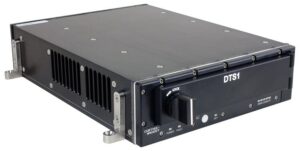 Curtiss-Wright’s Defense Solutions division has fully tested and validated its Data Transport System (DTS1) Network Attached Storage (NAS) device at the extended -45º to +85ºC operating temperature range as specified by MIL-STD-810G methods and procedures. The DTS1 is a Common Criteria certified, NSA (National Security Agency)-endorsed commercial off-the-shelf (COTS) NAS solution that support two layers of full disk encryption in a single device. It is ideal for rugged military applications, including high altitude, long endurance (HALE) UAS (unmanned aerial systems) platforms that must operate as high as 40,000 ft.
Curtiss-Wright’s Defense Solutions division has fully tested and validated its Data Transport System (DTS1) Network Attached Storage (NAS) device at the extended -45º to +85ºC operating temperature range as specified by MIL-STD-810G methods and procedures. The DTS1 is a Common Criteria certified, NSA (National Security Agency)-endorsed commercial off-the-shelf (COTS) NAS solution that support two layers of full disk encryption in a single device. It is ideal for rugged military applications, including high altitude, long endurance (HALE) UAS (unmanned aerial systems) platforms that must operate as high as 40,000 ft.
The DTS1 incorporates two distinct layers of AES 256-bit encryption into one device, providing effective, low-risk protection of Top Secret data. Both the hardware and software FDE layers have been individually evaluated and certified against two Common Criteria protection profiles: (1) collaborative Protection Profile for Full Disk Encryption – Encryption Engine; (2) collaborative Protection Profile for Full Disk Encryption – Authorization Acquisition. The DTS1 has also been approved to be on NATO’s Information Assurance Product List (NIAPC).
With a small form factor of 1.5 x 5.0 x 6.5” (38.1 x 127 x 165.1 mm) and weighing only 3.77 lb. (1.71 kg), the DTS1 supports PXE protocol so that network clients on a vehicle or aircraft can quickly boot from the encrypted files on the DTS1’s RMC. This approach both facilitates software updates for network clients and significantly reduces SWaP by eliminating the need for individual hard disks in each network client. Curtiss-Wright offers two mounting options for the DTS1, the VS-DTS1SL-FD, which is designed for cockpit use with DZUS mounting panel, and the VSDTS1SL-F, which uses L-brackets to support very flexible mounting within space-constrained platforms. The L-bracket configuration supports mounting on a cold plate for the extended temperature range.
The DTS1 enables any network-enabled device to retrieve stored data or save new captured data. Networked devices using heterogeneous operating systems (Linux, VxWorks, Windows, etc.) that support industry standard NAS protocols (NFS, CIFS, FTP, or HTTP) can store data on and retrieve data from the DTS1. The DTS1 also supports iSCSI protocol for block data storage and PCAP protocol for Ethernet packet capture. The DTS1 is designed to ensure system resiliency and secure operation to thwart cyber attacks.
The rugged small form-factor DTS1 NAS device is designed to store and protect large amounts of data on platforms such as UAVS as well as unmanned underwater vehicles (UUV), unmanned ground vehicles (UGV), and intelligence surveillance reconnaissance (ISR) aircraft that require the protection of sensitive DAR to international standards. It is ideal for rugged applications that require the storage, removal, and transport of critical data such as cockpit data (mission, map, maintenance), ISR (camera, I&Q, sensors), mobile applications (ground radar, ground mobile, airborne ISR pods), heavy industrial (steel, refinery), and video/audio data collection (flight test instrumentation). The device can be easily and quickly integrated into a complete rugged deployed system based on Curtiss-Wright’s broad range of open architecture single board computers and DSP modules, as well as fully integrated mission computers, sensor management systems, and network switches.
Lynn Bamford, President of Curtiss-Wright Defense and Power, commented: “We’re very excited that our industry-leading DTS1 network storage and encryption solution has now been validated for deployment in the harshest, most demanding military environments, whether at high altitude, on an unmanned aircraft, or in a space constrained, densely packed ground vehicle deployed in the desert,” said Lynn Bamford, President, Defense and Power. “With support for actively cooled -45º to +85ºC operation, the certified DTS1 is now able to support a much wider range of environmentally challenging applications, bringing cost-effective, NSA-approved protection of data-at-rest to many more programs.”
Find manufacturers of Embedded Computing for unmanned applications >>


















